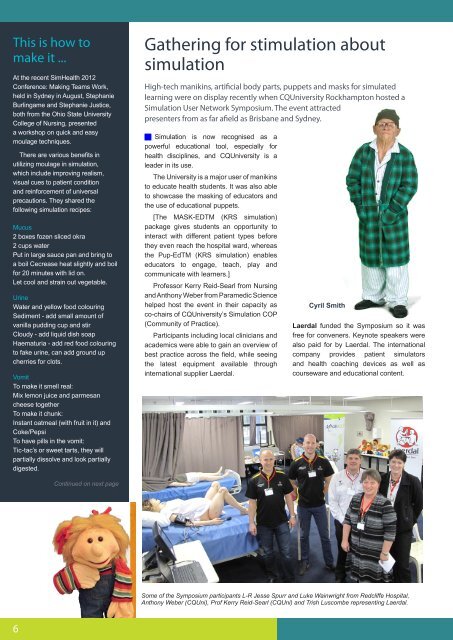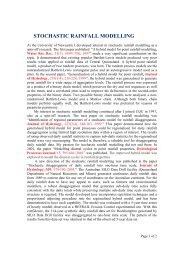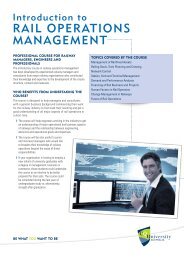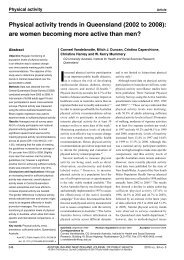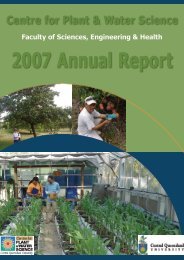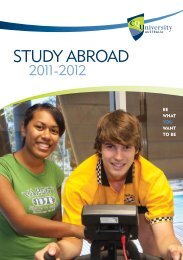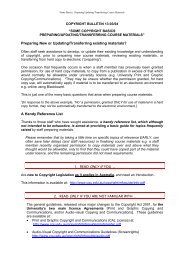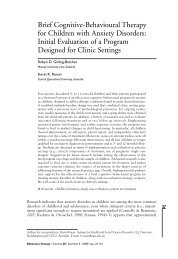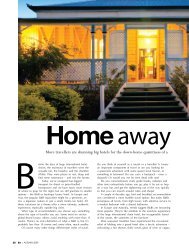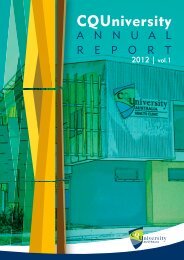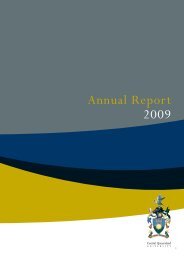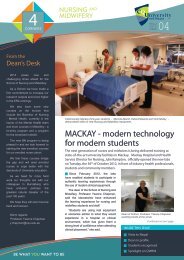4 Corners Newsletter - Vol 3 - Central Queensland University
4 Corners Newsletter - Vol 3 - Central Queensland University
4 Corners Newsletter - Vol 3 - Central Queensland University
You also want an ePaper? Increase the reach of your titles
YUMPU automatically turns print PDFs into web optimized ePapers that Google loves.
This is how to<br />
make it ...<br />
At the recent SimHealth 2012<br />
Conference: Making Teams Work,<br />
held in Sydney in August, Stephanie<br />
Burlingame and Stephanie Justice,<br />
both from the Ohio State <strong>University</strong><br />
College of Nursing, presented<br />
a workshop on quick and easy<br />
moulage techniques.<br />
There are various benefits in<br />
utilizing moulage in simulation,<br />
which include improving realism,<br />
visual cues to patient condition<br />
and reinforcement of universal<br />
precautions. They shared the<br />
following simulation recipes:<br />
Mucus<br />
2 boxes fozen sliced okra<br />
2 cups water<br />
Put in large sauce pan and bring to<br />
a boil Cecrease heat slightly and boil<br />
for 20 minutes with lid on.<br />
Let cool and strain out vegetable.<br />
Urine<br />
Water and yellow food colouring<br />
Sediment - add small amount of<br />
vanilla pudding cup and stir<br />
Cloudy - add liquid dish soap<br />
Haematuria - add red food colouring<br />
to fake urine, can add ground up<br />
cherries for clots.<br />
Vomit<br />
To make it smell real:<br />
Mix lemon juice and parmesan<br />
cheese together<br />
To make it chunk:<br />
Instant oatmeal (with fruit in it) and<br />
Coke/Pepsi<br />
To have pills in the vomit:<br />
Tic-tac’s or sweet tarts, they will<br />
partially dissolve and look partially<br />
digested.<br />
Gathering for stimulation about<br />
simulation<br />
High-tech manikins, artificial body parts, puppets and masks for simulated<br />
learning were on display recently when CQ<strong>University</strong> Rockhampton hosted a<br />
Simulation User Network Symposium. The event attracted<br />
presenters from as far afield as Brisbane and Sydney.<br />
Simulation is now recognised as a<br />
powerful educational tool, especially for<br />
health disciplines, and CQ<strong>University</strong> is a<br />
leader in its use.<br />
The <strong>University</strong> is a major user of manikins<br />
to educate health students. It was also able<br />
to showcase the masking of educators and<br />
the use of educational puppets.<br />
[The MASK-EDTM (KRS simulation)<br />
package gives students an opportunity to<br />
interact with different patient types before<br />
they even reach the hospital ward, whereas<br />
the Pup-EdTM (KRS simulation) enables<br />
educators to engage, teach, play and<br />
communicate with learners.]<br />
Professor Kerry Reid-Searl from Nursing<br />
and Anthony Weber from Paramedic Science<br />
helped host the event in their capacity as<br />
co-chairs of CQ<strong>University</strong>’s Simulation COP<br />
(Community of Practice).<br />
Participants including local clinicians and<br />
academics were able to gain an overview of<br />
best practice across the field, while seeing<br />
the latest equipment available through<br />
international supplier Laerdal.<br />
Cyril Smith<br />
Laerdal funded the Symposium so it was<br />
free for conveners. Keynote speakers were<br />
also paid for by Laerdal. The international<br />
company provides patient simulators<br />
and health coaching devices as well as<br />
courseware and educational content.<br />
Continued on next page<br />
Some of the Symposium participants L-R Jesse Spurr and Luke Wainwright from Redcliffe Hospital,<br />
Anthony Weber (CQUni), Prof Kerry Reid-Searl (CQUni) and Trish Luscombe representing Laerdal.<br />
6


